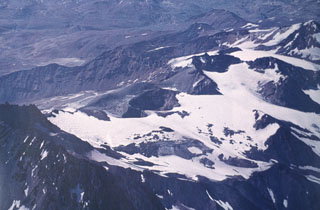Report on Planchon-Peteroa (Chile) — 13 January-19 January 2010
Smithsonian Institution / US Geological Survey
Weekly Volcanic Activity Report, 13 January-19 January 2010
Managing Editor: Sally Sennert.
Please cite this report as:
Global Volcanism Program, 2010. Report on Planchon-Peteroa (Chile) (Sennert, S, ed.). Weekly Volcanic Activity Report, 13 January-19 January 2010. Smithsonian Institution and US Geological Survey.
Planchon-Peteroa
Chile
35.223°S, 70.568°W; summit elev. 3977 m
All times are local (unless otherwise noted)
Based on pilot reports and photographs SERNAGEOMIN reported on 13 January that fumarolic plumes from Planchón-Peteroa rose 250 m high on 4, 6, and 7 January. Increased fumarolic activity is common on the warmest days in the summer when snow melts in the crater and more steam is produced.
Geological Summary. Planchón-Peteroa is an elongated complex volcano along the Chile-Argentina border with several overlapping calderas. Activity began in the Pleistocene with construction of the basaltic andesite to dacitic Volcán Azufre, followed by formation of the basaltic and basaltic andesite Volcán Planchón, 6 km N. About 11,500 years ago much of Azufre and part of Planchón collapsed, forming the massive Río Teno debris avalanche, which traveled 95 km to reach Chile's Central Valley. Subsequently, Volcán Planchón II was formed. The youngest volcano, andesitic and basaltic andesite Volcán Peteroa, consists of scattered vents between Azufre and Planchón, and and contains a small steaming crater lake. Reported eruptions from the complex have been dominantly explosive, although lava flows were emplaced in 1837 and 1937.
Source: Servicio Nacional de Geología y Minería (SERNAGEOMIN)

